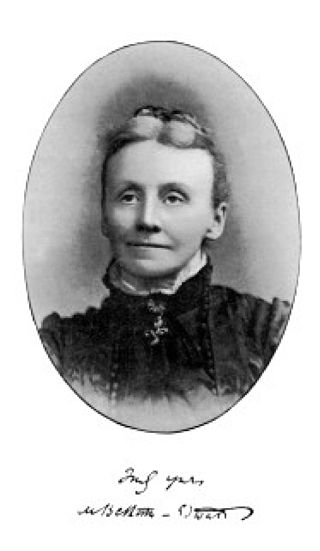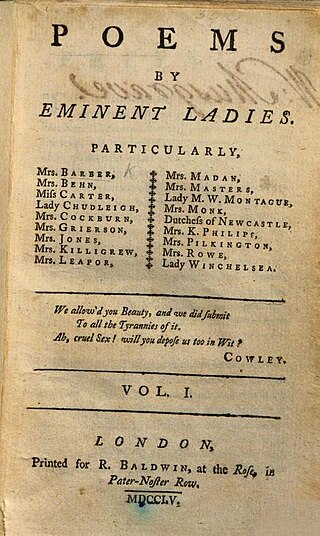Related Research Articles

Anna Seward was an English Romantic poet, often called the Swan of Lichfield. She benefited from her father's progressive views on female education.
Catherine Maria Fanshawe (1765–1834) was an English poet whose work was praised by Walter Scott. She and her sisters were also artists.

Mary Leapor (1722–1746) was an English poet, born in Marston St. Lawrence, Northamptonshire, the only child of Anne Sharman and Philip Leapor (1693–1771), a gardener. She, out of the many labouring-class writers of the period, was noticeably well received.

Matilda Betham-Edwards was an English novelist, travel writer and Francophile, and a prolific poet, who corresponded with several well-known English male poets of the day. In addition, she wrote a number of children's books.

Mary Barber, Irish poet, was a member of Swift's circle. She has been described as "a domestic, small-scale, early eighteenth-century poet of charm and intelligence, but also an incisive, often satirical commentator on social and gender issues."

Constantia Grierson, was an editor, poet, and classical scholar from County Kilkenny, Ireland. She is notable for her achievements as a classicist, which were all the more remarkable given her labouring-class background.
Maria Abdy, née Smith, also known as Mrs Adby, was an English poet.
Elizabeth Tollett was a British poet. Her surviving works are varied; she produced translations of classical themes, religious and philosophical poetry and poems arguing for women's involvement in education and intellectual pursuits such as natural philosophy. Unusually, for a woman of her time, her poetry also includes Newtonian imagery and ideas. Some of her poetry imitates the Latin verse of Horace, Ovid, and Virgil. In some of her poems, Tollett paraphrases the Psalms.

Mary Monck was a celebrated beauty and poet.
Mary Darwall, who sometimes wrote as Harriett Airey, was an English poet and playwright. She belonged to the Shenstone Circle of writers gathered round William Shenstone in the English Midlands. She later explored subjects that included the nature of female friendship and the place of women writers.
Elizabeth Anne Le Noir was an English female poet, novelist, and feminist from the romantic period. Raised in a widowed home, Le Noir became interested in literature through opportunities she was given by her mother's step-father; John Newbery. After being employed at the Reading Mercury for some time, Le Noir and her sister eventually inherited it. Le Noir soon became the wife of Jean Baptiste Le Noir, from whom she got her last name. Although she didn't have any children of her own, she educated two of her female relatives. Although Le Noir had many great works, "[s]he is probably better known as the daughter of the famous religious poet Christopher Smart."

Mary Mackellar was a prominent Highland Scottish poet, Scottish Gaelic-English translator and campaigner for a Gaelic language revival and the revival of Highland culture during the 19th century.
Agnes Lyon (1762–1840) was a Scottish humorous poet of the 18th and 19th century.
Martha Fowke, later Martha Sansom, was an English poet associated chiefly with the circle about Aaron Hill. She was the daughter of Major Thomas Fowke, an army officer murdered in 1708, and his wife Mary. Born in Hertfordshire on 1 May 1689 to a family of Roman Catholic gentry, she was educated at home and at boarding school. Her mother had been less supportive of her daughter's writing than her father. Fowke lived in London after her mother died in 1705, but moved to East Anglia in 1730 with her husband, Arnold Sansom, whom she had married around 1721. Their marriage was not a happy one.
Sarah Dixon was an English poet, probably born in Rochester, Kent, where she was baptised. She took to writing "during a Youth of much Leisure", although her earliest surviving dated poem is from 1716. The 500 subscribers to her anonymous Poems on Several Occasions included Elizabeth Carter and Alexander Pope, and the society hostess Maria Coventry, Countess of Coventry.
James Maxwell was a Scottish poet and essayist, known as the "Poet in Paisley".
Anne Evans was an English poet and composer. She has been described as "a witty poet and skilled composer of dance songs". Her Poems and Music were published posthumously in 1880.
Fidelia was a favoured female pseudonym among writers in English in the 18th century. It was derived from the Latin fidelitas, meaning faithfulness.

Mary Scott's The Female Advocate; a poem occasioned by reading Mr. Duncombe's Feminead (1775) is both a celebration of women's literary achievements, as well as an impassioned piece of advocacy for women's right to literary self-expression.

Elizabeth Teft was the author of a miscellany of occasional, topical, and political poetry. Although little is known of her life, her work has garnered scholarly interest.
References
Works cited
- Hadden, James Cuthbert (1894). . In Lee, Sidney (ed.). Dictionary of National Biography . Vol. 37. London: Smith, Elder & Co.
- Brown, Susan; Patricia Clements; Isobel Grundy, eds. (2006). "Mary Masters entry, overview screen". Orlando: Women's Writing in the British Isles from the Beginnings to the Present. Cambridge University Press Online. Retrieved 1 February 2015.
- Masters, Mary (1833). Poems on several occasions. London: T. Brown. Retrieved 1 February 2015.
- Demers, Patricia (2004). "Masters, Mary (fl. 1733–1755), poet and letter-writer". Oxford Dictionary of National Biography (online ed.). Oxford University Press. doi:10.1093/ref:odnb/18316.(Subscription or UK public library membership required.)
- Smith, Gwen D. (2000). "Women Writers - 17th & 18th century". Rare Book and Texana Collections. University of North Texas. Retrieved 1 February 2015.